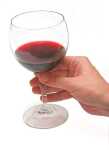The right wine glass can make a big difference

Wine glasses are an integral part of the wine experience. That is a pretty strong statement but it is absolutely true. We spent many years scoffing at wine snobs with their special glasses but in truth, we were wrong; very, very wrong.
We began our journey into wine glassware with a simple but very dramatic test. We tasted a Cabernet Savignon in a Riedel Bordeaux glass (the "proper" glass for a cab), and a simple, every day, run of the mill, found at Wal-Mart, generic wine glass. In the Bordeaux glass all of the subtle nuances of the wine were open and very obvious in both taste and aroma. The really dramatic effect was the generic glass. All that we could smell and taste was vanilla, oak, and alcohol, with absolutely none of the fruit showing up at all. It was truly an eye opener.
The reason for this turned out to be a bump and the fact that the proper glass directs the wine to the place on the tongue to best tastes the wine. This is due to the shape of the bowl but also to the fact that there is no rim (the bump) on the glass. The rim, that rolled edge at the top of the glass, creates turbulence as the wine enters the mouth and spreads the wine across the entire tongue rather that directing it to specific taste areas. Take a look at the rim or your wine glass; if it is rolled or you can feel or see a rim, it is not a good glass for wine, regardless of what you paid for it.
There are even more wine glass facts that are not wine snobbery. The proper amount of wine to pour into a glass is about two or three ounces so the wine aroma has plenty of room to expand in the glass and develop its full potential. Then there is the color of the glass. Any color, other that clear, is not acceptable for a wine glass, so that eliminates Aunt Sophie's purple wine glasses with the grape leaves on the stem that you inherited. A tinted or decorated glass will act to change the color of a wine. But there is more. Some wine glasses are made of common glass and have a slight, often unnoticed tint. Look down at the rim of the glass, in good light, and you will see color on poorer wine glass.
There is also the question of the thickness of the glass, the thinner the better. Lead-glass or as it is commonly known, crystal glass, is the best. It is colorless and can be made extremely thin while retaining its strength.
A new entrant to the wine glass market is the stemless, tumbler style. The idea of the stem on a wine glass proved to be a fallacy. It was thought that the heat of the hand would affect the wines flavor and aroma. Glass does not transmit heat well so there will be little adverse effect on the wine inside the glass. Another very import benefit to the stemless wine glasses is that they are less delicate and will not break as easily as the stemmed glass often does.
One final point about wine glasses. While good wine glasses dramatically enhance the enjoyment of any wine, their cost can be high. Wine snobbery dictates that you should own glasses specifically designed for a particular wine. There are glasses specific for Cabernet Sauvignon, Chardonnay, Sauvignon Blanc, Pinot Noir and on and on ad infinitum. While it is absolutely true that the wine specific glasses does offer the maximum reward to the drinker, the difference between them and the better generic wine glasses is slight and the price tag for the variety specific glasses can be astronomical.
Since we are approaching the holiday gift giving season it may be a good opportunity to purchase a new set of good wine glasses for yourself or the people you know who love wine.

